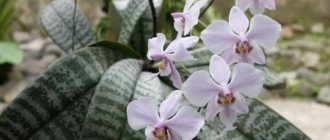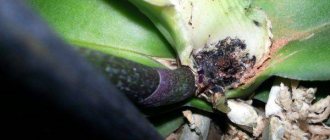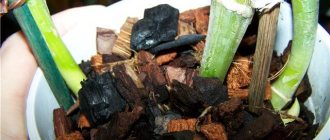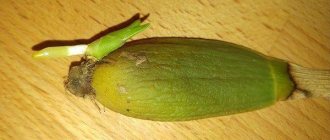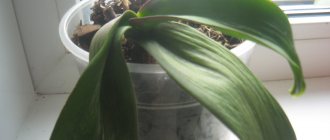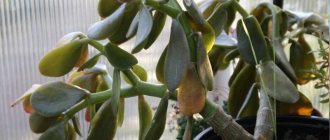How to understand why sticky drops appear and what to do
Drops and spots on the leaf blades warn orchid growers that their “pets” have problems, and force them to look for an answer to the question, when there are sticky drops on the orchid leaves, what to do.
What is transpiration
Transpiration is the evaporation of liquid through leaves, flowers, and stems. Droplets and white coating can spread over a large surface area of the leaves. They attract pollinating insects or pests.
Important! Sticky drops on orchids often do not pose a danger to the flower, as they form for natural reasons. They are washed off with water or washed with a soft cloth.
But often sticky leaves on orchids are signs of improper maintenance or disease. Then it is important to determine in time why they are formed.
Excessive watering
When overflowing, liquid accumulates near the surface layer of the substrate or remains in the pan. The situation can be aggravated by excessive brightness of lighting and inappropriate ambient temperature. If droplets appear on the leaves of the orchid, you need to perform the following steps:
- Move the container with the plant to a place where there is no direct sunlight.
- Dry the substrate.
- Add a drainage layer to improve air circulation.
Excess of fertilizing
Excessive feeding also leads to the release of flower nectar. In such a situation, the salt content in the substrate is reduced:
- The planting container is placed under running warm water.
- Allow the liquid to drain completely.
- The substrate is dried.
- No fertilizing is applied for three months.
- Subsequently, low concentration fertilizers are prepared and added to the pre-moistened substrate.
Pests on an orchid
If sticky droplets appear on the orchid, it must be carefully examined. There is a high probability that the plant is affected by pests: scale insects, aphids, mites, whiteflies. They can produce honeydew. Insects hide at the bottom of the leaf blades and feed on the sap of the flower. This causes the leaves to curl and they may turn yellow and dry out.
Powdery mildew
A large number of sticky transparent drops that turn into plaque is a sign of powdery mildew. This is a fungal disease that occurs when there is excessive humidity and high air temperature. Over time, the coating on the leaves darkens and the affected areas dry out.
Note! If you do not start fighting powdery mildew in a timely manner, there is a high risk of the orchid dying.
When to start worrying
There is no need to be particularly alarmed if the sweet dew is produced by the flower itself and is not a reaction to a parasite invasion.
However, it should be understood that sticky droplets may be an acceptable environment for the introduction and development of pathogenic microflora. So it’s still not advisable to leave them.
If the reason for the orchid's sticky leaves is an excess of nutrients, then you will have to act immediately. Excess fertilizer accumulated in the substrate often blocks the roots' ability to absorb moisture. It remains in the pot, causing rot to develop. As a result, the flower begins to wither, drops its buds, etc.
Similarly, you should be concerned if the plant has become infected with powdery mildew or has become a victim of pest attack. Here it is necessary to quickly diagnose and begin full treatment. Only with high efficiency there is a chance to protect the orchid from death.
Causes of droplets: how to determine in a specific orchid
If drops occur on an orchid, the reasons can be determined by carefully examining its leaves and stems.
When flower nectar is a natural phenomenon
If monitoring the condition of the plant did not help to identify excess moisture, the presence of insect pests, or fungal infections, we can conclude that the sticky secretions are the result of the normal functioning of the flower. There is no need to change conditions or use drugs; the plant is not in danger.
When sticky drops are a sign of care errors
When sugary secretions form, it is necessary to analyze the conditions in which the orchid grows. The reasons for transpiration may be the following:
- very low air humidity, less than 50%;
- the pot with the plant is in a draft;
- the air temperature is such that the orchid becomes hypothermic;
- lack of lighting or, on the contrary, its excess;
- watering is not organized correctly;
- excessive application of fertilizers.
If errors in care have been corrected, but flower nectar continues to be released, you need to check whether the plant is sick.
When sticky discharge is a sign of pest infestation
Insect pests are often difficult to detect with the naked eye. You need to examine the orchid with a magnifying glass. The following parasites can be seen on leaves and peduncles:
- Scaleworms. They look like small white lumps that can easily be confused with drops. Cell sap serves as food for them. Beetles harm plants by injecting poison into the leaves.
- Aphid. It can be seen without a magnifying glass on the back of the sheet plates. Insects secrete a sugary sticky liquid, so that the flower begins to become covered with a transparent coating.
- Shield. This dangerous pest forms a yellowish dome over its body, similar to drops.
- Spider mite. It reveals itself by the appearance of thin cobwebs, creating a white coating. When moisture settles on the web, a sticky layer appears.
Important! If pests are detected, the infected flower must be placed at a distance from other plants, preferably in a separate room, and treatment must begin.
Prevention
Having made sure that the sticky layer is relatively safe for your pet, it is important to create optimal conditions to protect the orchid from serious diseases :
- Temperature maintenance in summer: +22-25ºС, in winter +16-18ºС.
- Humidity 50-60%.
- Use only disinfected, tested substrate for planting and transplanting.
- Lighting is required to be diffused; in summer it is better to shade bright rays.
- Be sure to regularly ventilate the room.
- Moisturize the orchid once a week. The soil should dry out completely between waterings.
- Use high-quality water, without impurities and salts.
- Orchids need to be fertilized 2 times a month, especially during the flowering period. Use fertilizers with a predominant content of potassium and iron.
- Spray with water daily.
Due to improper care or violation of the watering schedule, phalaenopsis roots, leaves and other parts of the plant dry out, flowers and buds wither. Read our materials about how to take care of orchid roots to keep them healthy and how to recognize flower diseases.
How to save an orchid with improper care
The priority actions that help restore a plant if it is not properly cared for should be:
- Rinse the pot and leaf plates under a warm shower.
- In winter, during the dormant period, reduce watering. This will help avoid excess moisture, which causes infection.
- In summer, check whether the plant is suffering from low air quality. Water it regularly and take a warm shower.
- Spray the orchid with fungicide.
- Eliminate stagnant water in the leaf axils.
Preventive measures
Prevention of the appearance of sticky drops is the same as for other Phalaenopsis problems. Such measures include:
- proper watering;
- compliance with microclimate conditions;
- timely treatment with vitamin preparations and fungicides;
- periodic inspection of the plant.
Important! The drugs Fitosporin, Actellik, Aktara can also be used for the prevention of diseases. Their use prevents the appearance of parasitic insects.
Special vitamin cocktails, which include B vitamins and succinic acid, help strengthen the immunity of Phalaenopsis. It is useful to use such fertilizers to prevent flower diseases.
5/5 — (1 vote)
Signs of illness
Any indoor plant can get sick. The flower grower should take care of returning the flower to its previous appearance.
Why do orchid buds fall off: the main reasons for dropping them
If black spots are visible among the transparent drops, you should sound the alarm: powdery mildew is developing. The causative agent of powdery mildew is present in any soil, but increased activity occurs only under the following conditions:
- if the soil has a high nitrogen content;
- violation of watering - the flower is watered often;
- the flowerpots are too crowded - the orchid does not have enough air;
- the causative agent is the host itself.
Additional Information! First of all, on a diseased plant, you need to remove all damaged leaves.
Comprehensive measures against leaf spots:
- isolating the flower from other species, choosing a permanent sunny place;
- refusal to use fertilizers during treatment; after an illness, the orchid will need phosphorus-potassium compounds, but not nitrogen, to recover;
- a sick plant does not require a large amount of moisture;
- it is necessary to replace the soil, as colonies of fungi spread in the upper layer;
- during transplantation, the stem and healthy shoots should be sprayed with medicinal preparations, and the roots should be kept in a solution of the medicinal preparation;
- It wouldn't hurt to treat the flowerpot and tray.
When does phalaenopsis need help?
Types of mealybugs living on orchids
Mealybugs (false beetles, felt bugs, “hairy lice”) are a large family of hemipteran insects that are absolutely unrelated to worms. Many ignorant gardeners mistakenly confuse them with scale insects, although they are completely different.
The insect has a large oblong body (about 3-7 mm long), white or beige, which is covered with a waxy coating reminiscent of flour. On the sides it is evenly surrounded by bristles of several millimeters, and at the back it has two pairs of more elongated hairs.
Several hundred species of scale insects are known, but only three of them are dangerous for orchids:
- bristly - females are slightly red in color, dusted with “flour”. Males are like flies and fly;
- citrus - females are slightly pink in color with a light bloom. They leave honeydew (a sticky sweet secretion) on the orchid. Males are brown and capable of flight;
- seaside - females are gray-pink, males have wings.
Important: the pest most often affects the roots of plants, and also secretes a specific waxy secretion, which promotes the development of fungal diseases and prevents it from being destroyed by chemicals.
Danger to plants
Males are safe for the flower because they die after mating. Females are real parasites. With their mouthparts, they gnaw holes in the vine, sucking on it, drawing out life-giving juices, and building nests resembling cotton balls in the recesses of the leaves. In addition, they actively occupy stems and leaves, moving onto pots, windowsills and windows, covering everything with a cobwebby coating along the way. It blocks the stomata of plants, preventing them from “breathing,” spoils the appearance and depletes the flower.
In addition, having discovered a white sticky coating on an orchid, amateur flower growers often do not know how to treat and remove it correctly and may make mistakes when dealing with feltworm.
Female scale insects are extremely fertile. Laying is done up to 4 times a year. After 10 days, grayish larvae hatch and move quickly, choosing a place to feed. The insects are like fluff and can easily be transferred between plants even by weak air currents. They stick to the tender parts of the leaf, feed greedily and grow quickly. Before becoming an adult, they go through several molts.
This is interesting: there is an opinion that the wandering louse survives only on weakened plants - those that are dormant (in winter), have recently been exposed to disease, or have been attacked by other parasitic insects. And also as a result of improper care or depleted, long-unchanged soil.
Treatment options
Currently, there are a large number of ways to cure orchids and rid them of sticky plaque secretions.
- First, it is recommended to pay attention to watering . In winter, it should be significantly reduced. Indeed, due to the increased level of humidity, the infection will only develop.
- If plants are covered with small insects, they must be removed. This can be done manually, after which it is recommended to water the flowers with warm water. If an orchid is affected by a scale insect, it must also be treated with a solution of a special preparation containing oil.
- The sweet nectar that appears on the leaves and trunk is the waste product of the mealybug. At the same time, on the plates you can see the harmful insects themselves that got into the liquid.
- Plants are often affected by scale insects. This insect can be easily identified by its almost transparent semicircular shell. These parasites secrete a waxy substance that accumulates around them and over time forms a protective film.
- If the flowers are affected by mites, then you should first remove all damaged parts of the infected plant. After this, it must be replanted, and the pot in which it was located must be thoroughly rinsed with clean water.



